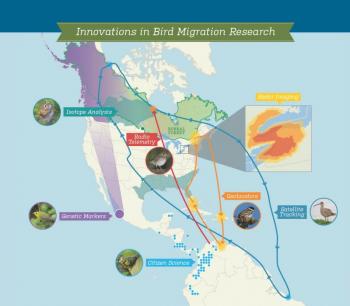New Research, More Conservation
We’ve written before about some of the amazing recent discoveries in bird migration that have resulted from the availability of new research technologies. Smaller and smaller satellite transmitters have made it possible to track more and more birds in almost real time over vast geographic distances. Whimbrels—those chicken-sized shorebirds with the long, down-curved bills—have been mapped flying from their Northwest Territories breeding grounds to stop-over locations in the Maritimes and New England in August where they often feed on the abundant blueberries and other low-to-the-ground berries. From our neck of the woods they eventually take off and make an epic three- to five-day non-stop migration to the Caribbean or South America. Satellite tags placed on golden eagles in the mid-Atlantic states in winter have shown that many of them fly through Maine on their way north to their breeding sites in northern Quebec and Labrador. Great shearwaters—gull-sized seabirds that spend their lives at sea—have been found to fly from sub-Antarctic nesting islands north to the opposite hemisphere during the southern hemisphere winter (our summer).
Tiny geolocators that keep track of sunrise, sunset, and day length times, and from which it is possible to determine geographic locations, have now been deployed on very small birds including sparrows and warblers. Blackpoll warblers fitted with geolocators on New England mountaintops have been found to make 48+ hour nonstop flights from New England or the mid-Atlantic states to Cuba or Hispaniola. They rest and refuel before making another similarly long nonstop flight to South America. Geolocators placed on Atlantic puffins nesting on some of our Maine islands were found to winter far offshore, off the coast from New York to the mid-Atlantic states.
Very small radio transmitter chips have been developed for use in bird research in the last 5 to 10 years and, along with an increase in the number of radio towers that can register the signals, they have vastly increased knowledge about bird movements. For example, we now know that semipalmated and white-rumped sandpipers using the shorelines of James Bay for feeding in July and August often make a single overnight flight over to the coast of Maine and other New England states before hopscotching their way south, eventually perhaps to South America.
All of these new discoveries certainly astound us as to the ability of these small birds to make athletic and navigational journeys that would make even the finest athletes and navigators pale in comparison. But what about if you are interested in assuring that bird and other wildlife populations, and the ecosystems within which they live, remain healthy and resilient? Are there findings from this new research that are relevant to conservation? Is so, what are they?
Perhaps one of the most obvious lessons from new bird migration research is the deeper understanding and appreciation for the shared responsibilities for bird populations across the hemisphere. Now we know that the responsibility we have for maintaining the stop-over habitat for whimbrels at Damariscove Island or for semipalmated sandpipers at Oven’s Mouth is shared with the First Nations of the Mushkegowuk Council of James and Hudson Bay, the islands nations of the Caribbean, and Brazil and other South American countries.
There are other lessons as well.
For a few bird species, scientists are finding that there are very specific hotspots that a large proportion of the population may rely upon for survival during migration or winter. But migration research has shown that the majority of bird species use a very large proportion of the landscape during migration. And from year to year the places that they use may change depending on how weather systems impact the routes that they can take and where they can find abundant food, water, and safety from predators. All of this means that efforts to protect, maintain, and restore natural habitats for migratory birds are now known to be of even higher priority than we might have considered before as our stewardship responsibility is highlighted from this new migration research.
While we marvel at the incredible migration feats and migration connections shown by our birds, let’s also keep supporting conservation efforts to give them their best chance of survival into the future.
Jeffrey V. Wells, Ph.D., is a Fellow of the Cornell Lab of Ornithology. Dr. Wells is one of the nation's leading bird experts and conservation biologists and author of the “Birder’s Conservation Handbook.” His grandfather, the late John Chase, was a columnist for the Boothbay Register for many years. Allison Childs Wells, formerly of the Cornell Lab of Ornithology, is a senior director at the Natural Resources Council of Maine, a nonprofit membership organization working statewide to protect the nature of Maine. Both are widely published natural history writers and are the authors of the popular book, “Maine’s Favorite Birds” (Tilbury House) and the just-released “Birds of Aruba, Bonaire, and Curaçao” from Cornell University Press.



























